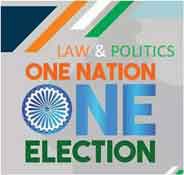How Does The Parliament Make Law: Different Types Of Majority
How does the Parliament make law: Different types of majority
Ordinarily, all business of the legislature requires that a motion or resolution or bill should get the support of a majority of the members voting at that time.Note: There are 543 seats in the House of People, i.e., Lok Sabha, and 245 seats in the Council of States i.e., Rajya Sabha. Based on the distribution of seats in the houses, the majority is decided.
Types of Majorities in the Indian Constitution:
- Simple Majority:
It means a majority of more than 50% of members are present on a particular day and voting on any bill or issue.For instance, there are a total of 543 seats in Lok Sabha and only 400 members are present on the day of voting. So, to pass a bill by a simple majority, a minimum of 201 votes will be required [(50% of 400) +1]. Bills and motions that can be passed by a simple majority are as follows:- No confidence motion in Lok Sabha only
- Vote of thanks on the president's address
- All the ordinary bills
- Confidence motion in Lok Sabha only
- Election of speaker
- Censure motion
- Financial bills
- Absolute Majority:
It means 50% + 1 of the total strength of the house.For instance, in the Lok Sabha, it will be 273 or more (i.e., 50% of 543+1). Note: As of now, it is not used in isolation under the Indian Constitution (used in combination with Special Majority). It is required when any political party forms its government for stability.
- Effective Majority:
It means more than 50% of the effective strength of the house.Effective strength = Total Strength - Vacancies Situations where it is needed are as follows:- For the removal of the Vice President in the Rajya Sabha
- Resolution seeking the removal of speaker and deputy speaker of Lok Sabha and State Legislative Assemblies
- Resolution seeking the removal of the Deputy Chairman of Rajya Sabha
Difference between Absolute and Effective Majority:
Absolute majority means more than 50% of the total strength of the house irrespective of the vacancies whereas, an effective majority is the majority of the total strength of the house after subtracting vacancies from it.
- Special Majority:
Special majority according to various Articles of the Indian Constitution are as follows:- According to Article 249 (when Rajya Sabha legislates in matters of State list) and Article 312 (when Rajya Sabha creates new All India Services), a special majority means 2/3rd of the members present and voting.
- For instance, in the case of Lok Sabha, out of 543 only 450 members are present at the time of voting. Thus, the special majority will be 301 (2/3rd of 450 + 1).
- According to Article 368, a special majority means 2/3rd of the members present and voting plus the majority of the total membership of the house (Absolute majority).
- For instance, in the case of Lok Sabha, it will be 301 (2/3rd of the members present and voting) plus 273 (Absolute majority).
Special Majority under Article 368 is needed for the following:
- Amendment of the Constitution
- Removal of a judge of the Supreme Court or a High Court.
- For the approval of the National Emergency
- To create or abolish the Legislative Council in a state.
If the party in power enjoys a very thin majority, it can pass legislation of its choice and get the budget approved even if the opposition does not agree. Thus, it needs to take at least some members of the opposition parties into confidence if it wants to amend the Constitution. This is mainly to make the procedure of amendment of the Constitution more rigid so as to protect its basic structure.
Hence, the basic idea behind the amending procedure is based on broad support among the political parties and parliamentarians.
According to Article 61, special majority means 2/3rd of the total strength of the house.
For instance, in the case of Lok Sabha, it will be 362+1 (2/3rd of 543 + 1).
This is the toughest kind of majority under the Constitution. It is used for the impeachment of the president under Article 61 of the Constitution.
Lastly, in the case of Constitution Amendment Bills that change the federal structure of the Nation, it has to be passed by a special majority of 2/3rd of the members present and voting in both houses plus ratification by Legislative Assemblies of more than half of States by a simple majority.
Conclusion:
Based on the above discussion, one can observe that the different types of majority under the Indian Constitution serve distinct purposes. Where a simple majority is essential for routine legislative matters, a special majority is required for significant decisions such as constitutional amendments. These provisions ensure a balance between stable governance and protecting the fundamental principles.
Law Article in India
Legal Question & Answers
Lawyers in India - Search By City
LawArticles
How To File For Mutual Divorce In Delhi

How To File For Mutual Divorce In Delhi Mutual Consent Divorce is the Simplest Way to Obtain a D...
Increased Age For Girls Marriage

It is hoped that the Prohibition of Child Marriage (Amendment) Bill, 2021, which intends to inc...
Facade of Social Media

One may very easily get absorbed in the lives of others as one scrolls through a Facebook news ...
Section 482 CrPc - Quashing Of FIR: Guid...

The Inherent power under Section 482 in The Code Of Criminal Procedure, 1973 (37th Chapter of t...
The Uniform Civil Code (UCC) in India: A...

The Uniform Civil Code (UCC) is a concept that proposes the unification of personal laws across...
Role Of Artificial Intelligence In Legal...

Artificial intelligence (AI) is revolutionizing various sectors of the economy, and the legal i...








Please Drop Your Comments